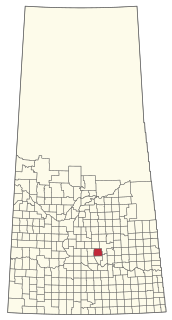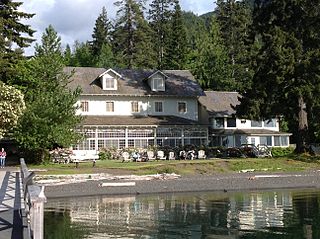
The Old Faithful Inn is a hotel in the western United States with a view of the Old Faithful Geyser, located in Yellowstone National Park, Wyoming. The Inn has a multi-story log lobby, flanked by long frame wings containing guest rooms. In the western portion of the park, it sits at an approximate elevation of 7,350 feet (2,240 m) above sea level.
A dining room is a room for consuming food. In modern times it is usually adjacent to the kitchen for convenience in serving, although in medieval times it was often on an entirely different floor level. Historically the dining room is furnished with a rather large dining table and several dining chairs; the most common shape is generally rectangular with two armed end chairs and an even number of un-armed side chairs along the long sides.

Disney's Grand Floridian Resort & Spa is a Victorian themed luxury hotel and spa located at the Walt Disney World Resort in Florida. The property opened on June 28, 1988, as the Grand Floridian Beach Resort. The name changed to Disney's Grand Floridian Resort & Spa during the fall of 1997. The resort contains 867 rooms among six buildings at an average of 400 square feet (37 m2) per room. The resort is owned and operated by Disney Parks, Experiences and Products.

The Prince of Wales Hotel is a historic hotel located in Waterton, Alberta, Canada. The hotel is situated within Waterton Lakes National Park, overlooking Upper Waterton Lakes. The hotel was designed by and built for the Great Northern Railway company. It is currently managed by the Pursuit Collection.

Government House, Regina, Saskatchewan, was constructed as a residence for the Lieutenant-Governor of the North-West Territories, whose territorial headquarters were in Regina until the provinces of Saskatchewan and Alberta were created out of the Territories in 1905 and Regina became the capital of Saskatchewan.

On December 27, 1832, two years after the organization of the Church of Christ, the movement's founder, Joseph Smith, stated he received a revelation that called upon church members to restore the practice of temple worship. The Latter Day Saints in Kirtland, Ohio were commanded to:
"Establish a house, even a house of prayer, a house of fasting, a house of faith, a house of learning, a house of glory, a house of order, a house of God."

Located near Dardanelle, Arkansas and rising about 1,350 feet (410 m) above the mountain valleys of west-central Arkansas to an elevation of about 1,755 feet (535 m) above sea level, Mount Nebo has views of 34,000 acres (140 km2) Lake Dardanelle, the Arkansas River and the surrounding mountain ridges. Atop this biblically named plateau is Mount Nebo State Park. Developed as a resort area in the late 19th century, it became a state park in 1928, its early development spearheaded by the Civilian Conservation Corps. Park activities include hiking, camping, and other outdoor pursuits.

Moose Mountain Provincial Park is a provincial park, located in south-eastern Saskatchewan 24 km north of the town of Carlyle on the Moose Mountain Upland. It is one of Saskatchewan's few parks with a community inside the park as there are several subdivisions with both year-round and seasonal residents. The village of Kenosee Lake is completely surrounded by the park but is not part of the park.
O'Connor's Landing was a family lakeside resort in Logan County, Ohio, United States, on the shores of Indian Lake. It was one of twenty-one hotels and cottage resorts listed in the 1911 travel atlas for the area. Indian Lake is formed by two forks of the Great Miami River and it resided at the confluence of the north and south forks. For the better part of the twentieth century, families came to visit and stay at the 30 cottages and 8-room hotel. The main building included a general store which provided bait, groceries, boat rentals and souvenirs. There was a restaurant located along the water for lakefront dining. It flourished until June 15, 1985, when it was destroyed by a fire. It was the last family style resort remaining on Indian Lake of the initial twenty one.
Stag Island is a private Canadian island located in the St. Clair River between Corunna, Ontario and Marysville, Michigan. The island currently houses over 100 cottages owned by both American and Canadian citizens. A ferry service is run from Corunna to the island by the Stag Island Auxiliary Club.

Katepwa is a resort village in the Canadian province of Saskatchewan within Census Division No. 6. It is on the eastern and southern shores of Katepwa Lake in the Rural Municipality of Abernethy No. 186. The name Katepwa likely comes from the Cree word Kahtapwao meaning "What is calling?" The name was given to the last in the chain of four lakes, Katepwa Lake. Legend has it that spirits inhabited the shores of the lake and First Nation people would hear voices on the lake.

The Rural Municipality of Last Mountain Valley No. 250 is a rural municipality (RM) in the Canadian province of Saskatchewan within Census Division No. 11 and SARM Division No. 5.

The Sans Souci Hotel was a hotel located in Ballston Spa, Saratoga County, New York. It was built in 1803 and torn down in 1887.

Lake Crescent Lodge, originally called Singer's Lake Crescent Tavern, is a historic resort situated on the shores of Lake Crescent west of Port Angeles, Washington. Located on the Olympic Peninsula within Olympic National Park, the Lodge is owned by the National Park Service and operated by Aramark. The Lodge resort is open seasonally from early May until the end of January with select cabins available during the winter months. Hiking and boating are popular activities for guests, and several peaks, including Mount Storm King and Pyramid Mountain, are easily accessible from the resort. Other hiking opportunities include Marymere Falls, Spruce Railroad, and Barnes Creek Trails.

Since 1895, Fountain Park has hosted an annual Chatauqua to promote traditional values and religious, social and educational activities. It was added to the National Register of Historic Places on December 7, 2001.
The Incola Hotel was a luxury hotel constructed by the Canadian Pacific Railway (CPR) company in the city of Penticton, British Columbia, Canada to provide quality accommodation for those traveling on the CPR mainline or steamships and passing through Penticton. The hotel opened in 1912 and served the city for 70 years before eventually being demolished in 1981.

Lakes Creek Hotel is a heritage-listed hotel at 431 Lakes Creek Road, Koongal, Rockhampton Region, Queensland, Australia. It was designed by Eaton & Bates and built in 1895 by T Moir. It was added to the Queensland Heritage Register on 21 October 1992.

Atatürk Museum Mansion is a historic house museum in Ankara, Turkey. It was the residence of President Mustafa Kemal Atatürk between 1921 and 1932, during the early years of the Republic. The museum is situated on Çankaya St. within the Çankaya Campus. It is situated right beside the Çankaya Mansion.

The City Hotel (1794–1849) stood at 123 Broadway, occupying the whole block bounded by Cedar, Temple, and Thames Streets, in today's Financial District of Manhattan, New York City. It was the first functioning hotel in the United States. Until the early 1840s it was the city's principal site for prestigious social functions and concerts. Designed by John McComb Jr., it offered not only luxurious accommodations, but also such amenities as shops, a barroom, and a coffeehouse, as well as public dining and dancing. Its five stories and 137 rooms replaced the former home of Stephen Delancey, built around 1700, which had become an inn.

Pine Inn, once called the Hotel Carmelo, is one of the early first-class Arts and Crafts, Tudor, Spanish style hotels established in Carmel-by-the-Sea, California. The Pine Inn is a historical resource dating back to 1889 when pioneer Santiago J. Duckworth built Hotel Carmelo. James Franklin Devendorf, renamed the hotel the "Pine Inn" in 1904. Today, it is a full-service hotel. The Pine Inn qualified for inclusion in the city's Downtown Historic District Property Survey, and was registered with the California Register of Historical Resources on March 18, 2003. The Inn is significant under the California Register criterion 1, as the first hotel in the history of the downtown district of Carmel-by-the-Sea.

















